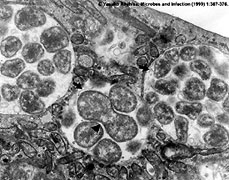
The transmission electron micrograph (magnified x 45,700) shows Ehrlichia chaffeensis in the cytoplasm of cells. Note: E. chaffeensis is enveloped by two layers of membranes and has tubular extracellular appendages (see arrows). This tick-borne rickettsia has been responsible for the recent death of a northeast Missouri child.
The Jasper County Health Dept. has received confirmation of a tick-borne disease-related fatality of a Missouri citizen. A northeast Missouri child died May 23, 2007. Diagnostic tests performed at St. Louis Children’s Hospital indicate the child was infected with Ehrlichia chaffeensis, caused by a tick-borne rickettsia, a genus of bacteria that replicates in the cytoplasm and nucleus of their host cell. Human monocytic ehrlichiosis (HME)further caused by Ehrlichia chaffeensis is a disease that the Pediatric Infectious Disease Journal reports as there being a "limited knowledge about its clinical course" and that "more work is needed to understand the true burden of the disease and the natural history among asymptomatically and symptomatically infected children."
Missouri Department of Health and Senior Services (DHSS) and local public health disease investigators found that the child had been hospitalized with symptoms consistent with ehrlichiosis after apparently being bitten by a tick. The child died about 10 days after symptoms initially appeared despite intensive medical care.
Missouri residents are at risk for tick-borne illness. From January 1 to June 1, 2007, cases of suspected and confirmed tick-borne rickettsial diseases (TBRDs), including ehrlichiosis/anaplasmosis and Rocky Mountain spotted fever (RMSF), have increased in Missouri compared to the previous five years. From June 8 through June 13, the Jasper County Health Department had received reports on six cases of tick-borne illnesses.
Ticks can transmit a number of illnesses. They include:
- Lyme-like disease – bacterial from an infected deer tick; treatable with antibiotics
- Ehrlichiosis – bacterial disease
- Rocky Mtn Spotted fever – 95-97% curable; can be fatal without treatment
- Tularemia – “rabbit fever”; bacterial disease
Health-care providers should be aware of the signs and symptoms of these diseases, which include fever, headache, malaise, and rash. Rash is much more common in RMSF (90%) compared with ehrlichiosis/anaplasmosis (<10%-60%).
Ticks are generally found after the last frost, but can be present all year. They feed on blood from animals and humans usually biting humans in warm places like underarms, at the sock-line, behind the ears, under tight-fitting clothing and in the hair.
Inserting their mouth into a human’s skin and extracting blood, ticks can transfer diseases to humans through their body fluid, such as saliva and blood, but are most likely to transmit bacteria after feeding for two or more days.
The most effective way to prevent tick-borne disease is to limit exposure to ticks by avoiding their habitat in moist, cool places under ground cover, brush or leaves. If that is not possible, health care officials recommend using an insect repellent that contains DEET according to manufacturer instructions and washing it off the skin when returning indoors. They also suggest wearing light colored clothing so ticks are easier to spot; wearing long pants, socks and shoes; and tucking the pants into the socks.
Caution should be used when removing ticks. The preferable method is to grasp the tick with tweezers as near to the skin as possible and pull the tick off with a steady pressure rather than a twisting or jerking motion. After tick removal, wash the bite site with soap and water and watch for complications, especially those that develop when the tick's mouth breaks off in the skin. Store the tick in a sealed freezer bag labeled with the date of the bite for 2-3 weeks in case complications do develop.






Comments